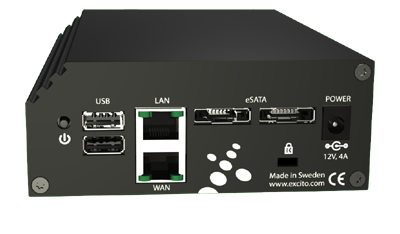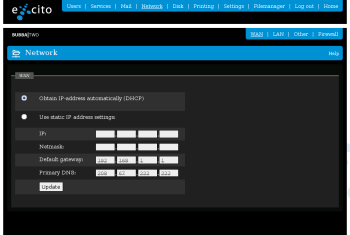Author: Dmitri Popov
Converting an old PC into a home or office server may look like a good idea on paper, but in reality, the idea has a few serious drawbacks. For starters, old PCs tend to be noisy, power-guzzling monsters, and older components make them less reliable. Turning an old PC into a server also means installing and configuring all the necessary software, which can be a time-consuming and laborious process. If the drawbacks of this approach outweigh for you its possible advantages, consider instead Bubba Two, a nifty Debian-based device that can be used for a variety of tasks.

Bubba Two arrives in a nondescript package containing the server itself, a power supply, a crossover Ethernet cable, and a two-page getting started guide. The server is surprisingly small — about the size of of two stacked VHS tapes — and thanks to its low-power processor and passive cooling, the only moving part in it is a hard disk. While the server is not completely noiseless, it’s quiet enough for most environments. My review unit came with a 500GB hard disk, but Bubba Two is available in other configurations, or without any disk at all. Bubba Two is based on a 200MHz ARM9 processor backed up by 256MB DDR2 RAM. The server consumes only between 7 and 12W of power, depending on the installed hard disk. Bubba Two’s body is made of solid aluminum, and it feels like it can withstand anything, with the possible exception of a direct hit by an anti-tank rocket. A thin layer of sprayed rubber gives the server a classy black finish reminiscent of IBM ThinkPad laptops. The back panel of the server sports two Ethernet jacks marked as WAN and LAN, two USB ports, and two eSATA ports for adding more storage and connecting a printer. There’s also a power connector.
The supplied quick start guide provides a brief explanation of how to get the server up and running. However, the setup procedure in the guide describes only one usage scenario, where Bubba Two sits between your Internet connection and local network, acting as a router and firewall. If you want to use Bubba Two purely as a server on a local network, you should look at Bubba Two’s manual, which covers other possible scenarios.
The initial configuration of Bubba Two takes only a couple of minutes. Use the supplied crossover cable to connect Bubba Two directly to your computer via LAN ports (you need this computer to configure Bubba’s settings). Turn the server on, wait till it boots, then point a browser on the connected computer to http://bubba. Log in as administrator using the default user name and password, and add a new user. That’s it: your server is ready to go.
Bubba Two comes with a vast collection of preinstalled software, which makes it suitable for a wide range of tasks. You can use Bubba Two as a file server with support for the HTTP, Samba, FTP, and SCP protocols. Apache allows you to use Bubba Two as a tiny Web server, and publishing Web pages is as easy as copying them to the Web folder in your user directory on the server. Since Bubba Two comes with both PHP and MySQL, you can use it to host LAMP-based applications. It took me literally five minutes to get DokuWiki up and running on Bubba Two.
Fetchmail lets you retrieve messages from multiple email accounts, and you can read them in a browser via the Web-based PIM and email front end. The Firefly media server can stream music stored in the music directory to DAAP-compatible music clients. The server even comes with its own downloader, which lets you download files via HTTP, FTP, and BitTorrent. As if this weren’t enough, you can use Bubba Two as a print server courtesy of the CUPS printer software. The best part is that all this functionality is wrapped in an intuitive and easy-to-use Web-based interface, so configuring Bubba Two doesn’t require any system administrator skills.
The server sports a nifty feature called EasyFind that can come in handy if you want to access Bubba Two from the Web but you don’t have a static IP address. Give your Bubba Two server a unique name, like “littlebubba,” and you can access the server using the littlebubba.bubbaserver.com address.
Since Bubba Two runs Debian Etch, you can treat it as a regular Linux system. You can connect to the server via SSH, manage it, and install additional software. Install, for example, the rsync package, and you can use Bubba Two as a backup server (this post on an Excito forum describes how to use Bubba Two for automated rsync backup).
Simply put, Bubba Two is as good as a simple server appliance gets. It can handle pretty much any task you throw at it, while the easy-to-use Web interface makes server configuration and maintenance a breeze. The tiny size and discrete design coupled with low power consumption and low noise level make Bubba Two a perfect solution for home and small offices. In other words, if you are looking for a small and versatile Linux-based server, Bubba Two should be at the very top of your list.
Categories:
- Reviews
- Server Hardware


